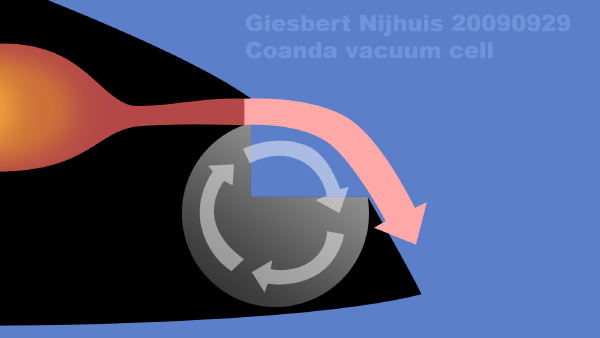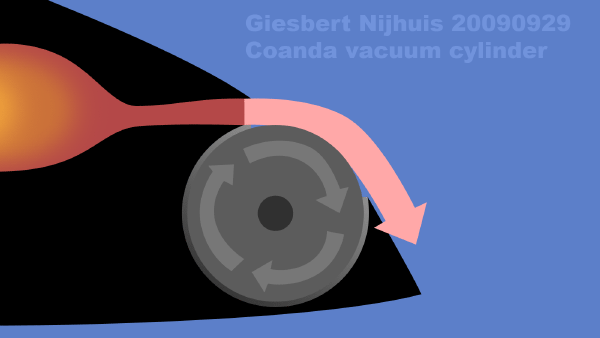|
|
|
COANDA EFFECT
Used on a VTOL aircraft
PAGE 1 PAGE 2
|
OPTIMIZING THE COANDA EFFECT
|
|
|
|
IMPORTANTCE OF GEOMETRY in optimizing the Coanda effect is demonstrated by these shadow photographs. At left is the flow of an undeflected jet of air. With a curved surface outside the slit (middle) the air tends to follow the surface, but with distortions. A step at the exit of the slit (right) produced a better flow but not an ideal one because the air impinged on the surface.
|

|
|
FURTHER MODIFICATIONS showed (left) that too high a step can cause the flow to separate from the surface. With a grooved surface (middle) the flow was undistorted. A well-balanced geometry (right) proved an ideal flow that was tangent to the surface.
"Step near slit proved to be crucial in maintaining good lift"
"The small step at the very lip of the slit is important because it turns the flow from the slit into an eddy, or vortex, which in this [circular] device rings the entire nozzle and therefore forms what is called a ring vortex. It is the vortex—or rather the low pressure generated within it— that causes the stream from the slit to bend and thus follow the contour of the shoulder. The curving of the stream around the shoulder produces a force directly radially outward; this force, tending to pull air away from the shoulder surface, apparently accounts for the relative vacuum, or suction, next to the surface. To maintain the suction, which prevents separation of the stream from the surface and causes the flow to accelerate, the stream must hug the shoulder surface closely without actually impinging on it or adhering to it.
Our experiments showed clearly that the creation of a stable Coanda effect depends on the appropriate adjustment of many factors: the diameter of the slit, the strength of the jet, the depth of the shoulder contour. Particularly crucial is the ratio of the slit diameter to the diameter of the nozzle as a whole. If the slit is too wide in relation to the shoulder breadth, the stream will tend to detach itself from the surface; if it is too narrow, the stream will tend to stick to the surface. Also important is the texture of the surface: a properly roughened surface helps to prevent distortion of the stream flow. In short, it takes a complex set of arrangements to produce a useful Coanda effect. It is no wonder that most investigators of the effect had found it to be an elusive phenomenon.
(source: "Applications of the Coanda Effect" by Imants Reba and Assistant Edward Wohlthausen, which appeared in the June 1966 edition of Scientific American.)
So, according to these tests by Imants Reba it's more efficient to create a "vacuum cell" than to blow the jet of air attached to a curved surface!
Similar to a Spay diffuser, a which one can blow and spay varnish on a drawing.
That makes sense, because the difference in speed between the jet and the solid surface is high, thus causing turbulence and all.
A coanda vacuum cell would be something like this:
|

|
|
Though beware of the air impinging (hitting) on the lower surface. Maybe an automatically adjusting lower surface flap can be made.
Another way to prevent friction between the jet of air and the surface, is to move the surface equally fast. Blowing the jet for example over a fast spinning cylinder. The jet of air drives the cylinder, so no extra motor is needed.
Something like this:
|

|
An ordinary propulsion jet pushes a mass of air away, to get an equal but opposite push, with which it can force an aircraft through the air. The rule for efficiency here is: the larger the air's mass, the more efficient the propulsion is. That is why modern subsonic airliners have jet engines with a very high bypass ratio. Turbine driven fans is what they have become.
A Coanda thruster is something different. Its goal is to lower the atmospheric pressure at the side where it wants to go, and let the atmospheric pressure push the craft there. When lowering the atmospheric pressure with a jet of air, the rule is not "the more mass the better", because a large air mass with little speed can't suck a cell vacuum. The opposite seems the efficient way to go here: the faster the drive jet goes, the more suction you'll get, up to a point because I don't think a supersonic jet of air doesn't suck well. I'm just speculating here, have no test data to proof it right.
|
|
|

